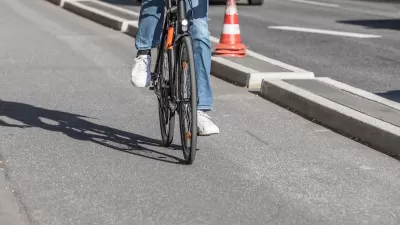A protected bike lane project in Downtown Los Angeles has ceded too much ground to cars, according to this opinion piece. If only it were the only example to choose from.
Matthew Fleischer, senior digital editor of the Opinion section of the Los Angeles Times and founder of its Livable City vertical, takes a strong position on Los Angeles bike infrastructure in a recent opinion piece.
In short: it isn't good enough.
Fleischer is mostly writing about the MyFigueroa complete streets project (see also the city's website for the MyFigueroa project), which in the decade since renderings that announced a potentially groundbreaking advancement in creating walkable and active public space (I wrote credulously on the subject in 2012) has transformed into a reality that Fleischer describes as a "monument to half-baked efforts."
Fleischer knows well the stakes of the choices made to provide people on bikes with safe facilities for riding around a city: he fell off his bike in Downtown Los Angeles and suffered a head injury.
"For bicyclists, walkers and, increasingly, scooter users, my story will hardly be surprising," writes Fleischer. "Yes, L.A. has bike lanes and pedestrian 'scrambles' and other 'alternative transit infrastructure' designed to protect vulnerable road users. But the infrastructure is spotty, badly maintained and confusing for drivers and cyclists. It can be almost as dangerous as no infrastructure at all."
Los Angeles' transit projects have also been accused of similar shortcomings in the past, as have projects in many other cities, and it's always a good time to consider whether a more complete commitment to allowing safe travel for more efficient modes would help deliver results that reflect ambitions.
FULL STORY: MyFigueroa is everything wrong with L.A.’s alternative transit efforts

Alabama: Trump Terminates Settlements for Black Communities Harmed By Raw Sewage
Trump deemed the landmark civil rights agreement “illegal DEI and environmental justice policy.”

Planetizen Federal Action Tracker
A weekly monitor of how Trump’s orders and actions are impacting planners and planning in America.

The 120 Year Old Tiny Home Villages That Sheltered San Francisco’s Earthquake Refugees
More than a century ago, San Francisco mobilized to house thousands of residents displaced by the 1906 earthquake. Could their strategy offer a model for the present?

In Both Crashes and Crime, Public Transportation is Far Safer than Driving
Contrary to popular assumptions, public transportation has far lower crash and crime rates than automobile travel. For safer communities, improve and encourage transit travel.

Report: Zoning Reforms Should Complement Nashville’s Ambitious Transit Plan
Without reform, restrictive zoning codes will limit the impact of the city’s planned transit expansion and could exclude some of the residents who depend on transit the most.

Judge Orders Release of Frozen IRA, IIJA Funding
The decision is a victory for environmental groups who charged that freezing funds for critical infrastructure and disaster response programs caused “real and irreparable harm” to communities.
Urban Design for Planners 1: Software Tools
This six-course series explores essential urban design concepts using open source software and equips planners with the tools they need to participate fully in the urban design process.
Planning for Universal Design
Learn the tools for implementing Universal Design in planning regulations.
Clanton & Associates, Inc.
Jessamine County Fiscal Court
Institute for Housing and Urban Development Studies (IHS)
City of Grandview
Harvard GSD Executive Education
Toledo-Lucas County Plan Commissions
Salt Lake City
NYU Wagner Graduate School of Public Service




























